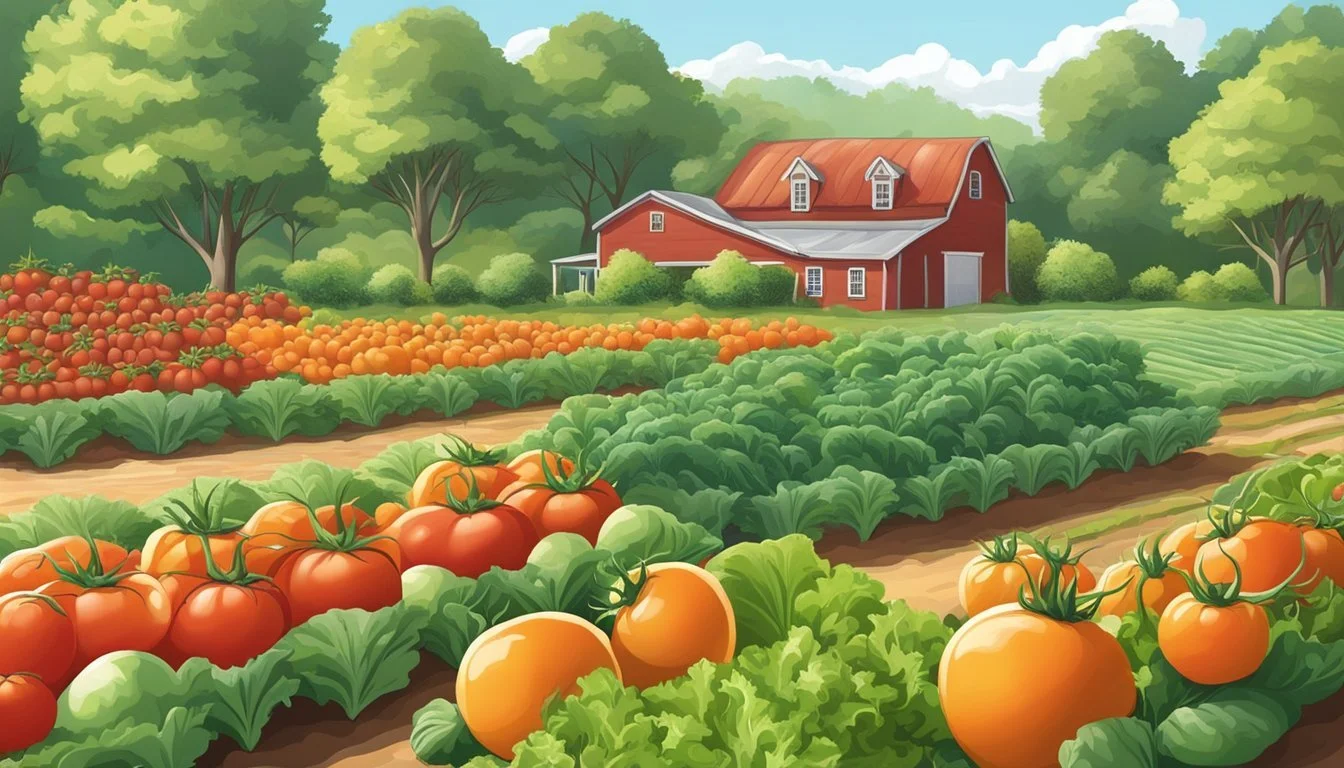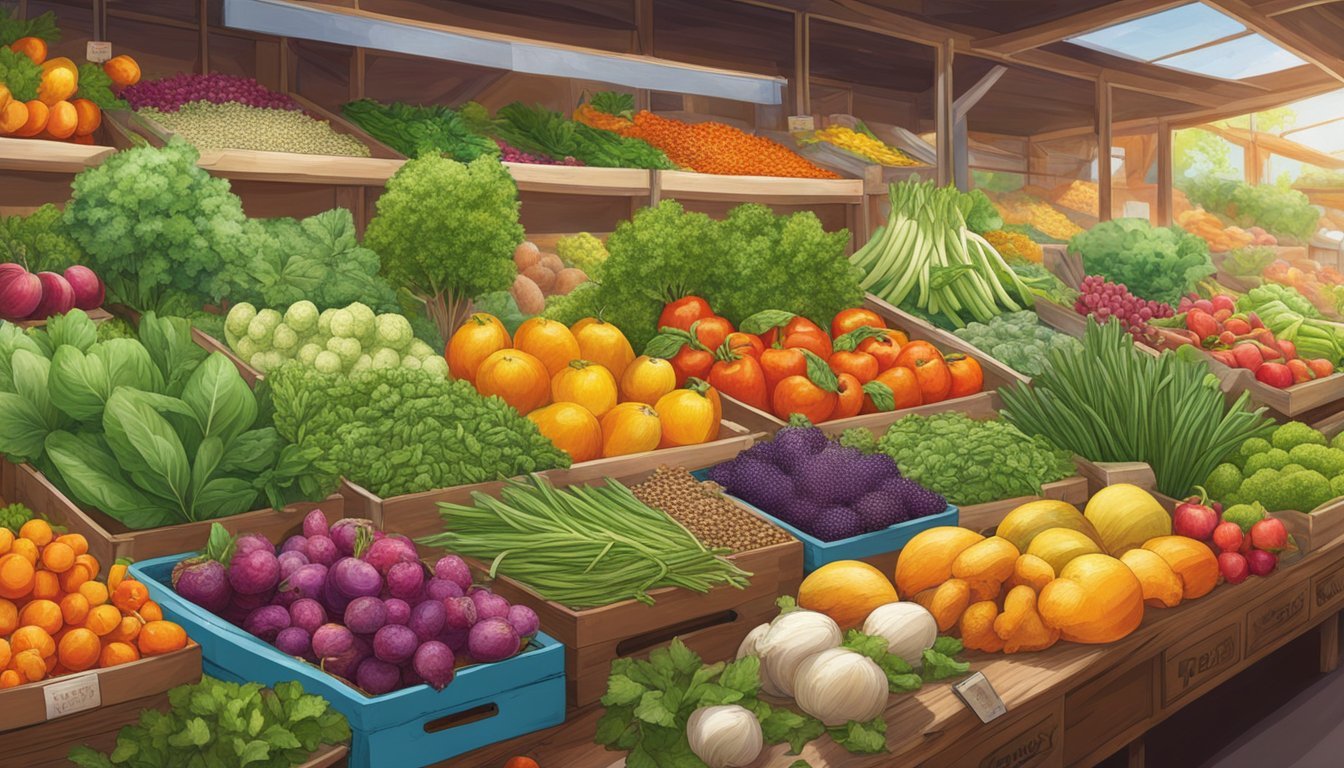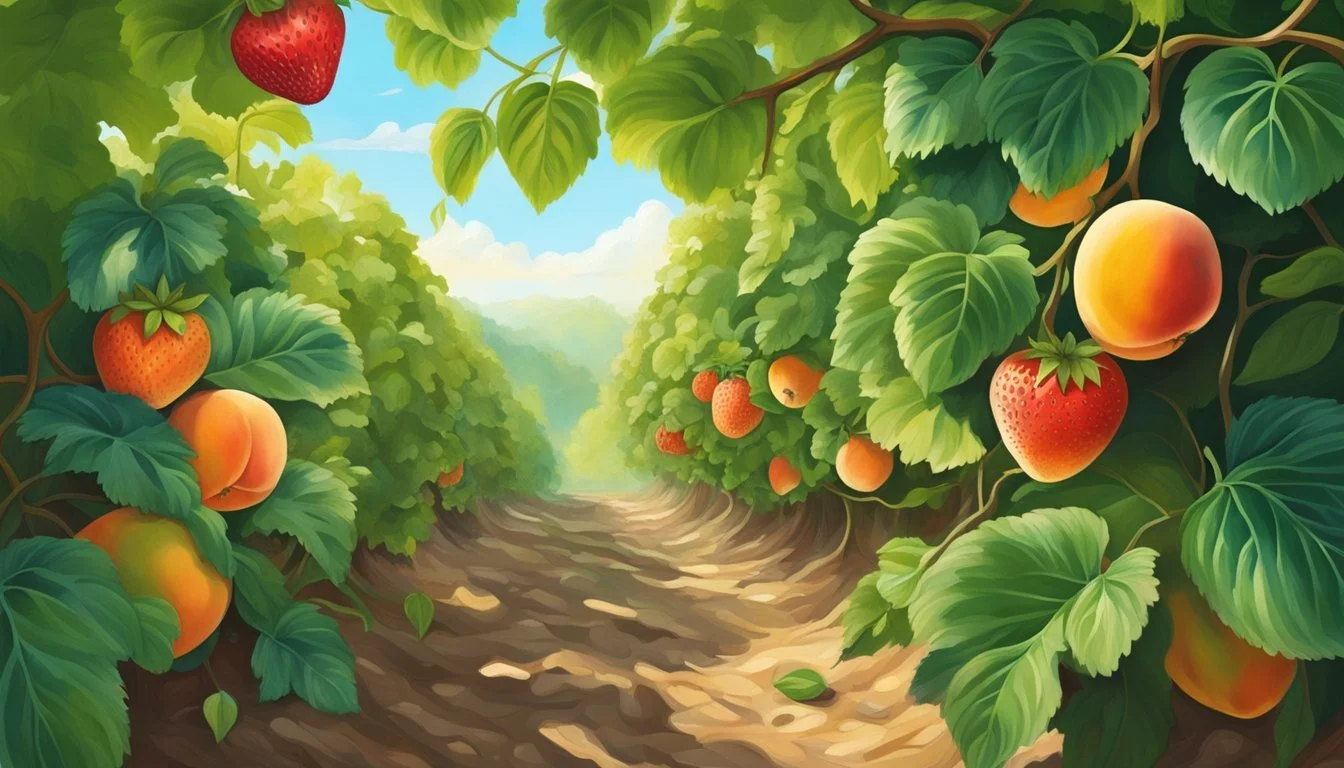Georgia Seasonal Fruit & Vegetables in April
A Guide to Fresh Produce
This Article is Part of our Georgia Seasonal Fruit & Veg Calendar
April in Georgia brings a rejuvenation of its fields and markets with a variety of fresh and flavorful produce. During this month, the state’s farms commence harvests that are reflective of both the spring season's tender beginnings and the lingering chill from the tail end of winter. The agricultural output is marked by a bounty of fruits (What wine goes well with fruit?) and vegetables that are not just at their peak of freshness but are also packed with flavor and nutrients.
Seasonal produce reaches the marketplace with the promise of locally-grown quality and ecological sustainability. Consumers can find an abundance of arugula, making its way from the fields to the salad bowls, and asparagus (What wine goes well with asparagus?) spears that are ideal for a range of nutritious dishes. Root vegetables such as beets also share the spotlight, offering earthy flavors to springtime recipes.
The picking season for Georgia blueberries (how long do blueberries last?), known for their juicy sweetness, begins towards the end of the month, providing a hint of the summer fruit bounty to come. On the vegetable front, broccoli can be found in abundance, perfect for a variety of healthful dishes. April’s produce palette ensures that local and seasonal eating in Georgia is both a flavorful and environmentally conscious choice.
Overview of Georgia's Seasonal Crops
In April, Georgia's fields and orchards are bustling with a variety of fresh produce. The state's temperate climate and fertile soil contribute to a rich harvest of both fruit and vegetables during this spring month. Local markets and farms offer a glimpse of Georgia's seasonal bounty.
Fruits: April is a transitional month for fruit in Georgia. While one might not find the famed Georgia peach ripe for picking just yet, there are other fruits that grace the tables.
Strawberries start to peak and are commonly found at pick-your-own farms.
Blueberries begin their season towards the end of the month.
Vegetables: April is truly the time for vegetables in Georgia, with a wide range that are ready to be harvested.
Asparagus emerges as a springtime favorite.
Carrots, beetroots, and radishes add color and nutrition to the selection.
Leafy greens such as lettuce, spinach (What wine goes well with spinach?), and kale thrive in the cool, early spring weather.
Cruciferous vegetables like broccoli and cabbage are also in season, offering robust flavors and health benefits.
Georgia’s spring month of April provides ample opportunities for one to enjoy fresh, locally grown produce. The state’s dedication to agriculture ensures that the selection of fruits and vegetables not only supports local economies but also delivers exceptional quality and taste to consumers.
Fruits in Season
In April, enthusiasts of fresh produce can eagerly anticipate the arrival of certain berries in Georgia. It marks a period when strawberries and blueberries begin to reach their peak flavor profile, hinting at the onset of their prime harvesting season.
Strawberries
April in Georgia heralds the beginning of the strawberry season. Harvested fresh, these berries offer a delightful balance of sweetness and acidity, making them a favored choice among fruit lovers. Due to the region's climate, strawberries are at their peak flavor in April, presenting an excellent opportunity for consumers to source them from local markets for a genuine taste of spring.
Blueberries
While blueberries will soon follow strawberries in reaching their season's peak, they start to become available in April, as well. Blueberries harvested during this time are praised for their rich, vibrant flavor. The region's April climate contributes to the development of blueberries' distinctively robust taste, positioning them as another seasonal highlight for both culinary applications and fresh snacking.
Vegetables Ready for Harvest
April in Georgia is a bountiful time for harvesting a variety of fresh vegetables. Farmers and gardeners can take advantage of the warming weather to gather the ripe produce from their fields and gardens.
Asparagus
Asparagus thrives in the transitional spring climate of Georgia. Harvesting typically commences when the spears are 6 to 8 inches tall and roughly the thickness of a pencil, ensuring they are tender and flavorful.
Greens
Lettuce, a cool-season crop, is ready to be picked in April. Gardeners should look for full, lush heads that are firm to the touch. They should harvest in the morning when leaves are crisp for optimal freshness.
Root Vegetables
Various root vegetables are mature and can be carefully dug up this month. Carrots should be harvested when they've developed a deep color and a firm texture. Radishes are also prime for picking, usually being ready when they're about an inch in diameter. Leeks may be harvested once their stems have reached an inch or more in width. Gardeners should check the soil conditions, ensuring it's not too wet or compacted, to avoid damaging the produce when pulling it from the ground.
Understanding Harvest Times
Georgia's April harvest brings a variety of fresh produce to the table, marking a period where spring crops are maturing and the pre-summer bounty begins to emerge.
Spring Crops
Peas and beans are two of the star performers in April's harvest calendar. They thrive in Georgia's spring climate and set the stage for the abundant growing season ahead.
Peas: These are typically ready for harvest in late April. One can expect to find a range of peas including, but not limited to, sugar snap and snow peas.
Beans: Different bean varieties start to become available and will continue to do so into May and June.
Pre-Summer Harvest
As Georgia transitions from spring to summer, the harvest times adapt to the changing climate, setting the scene for an early taste of summery crops.
Strawberries: While not a vegetable, these berries are a notable mention, as they begin to ripen and are usually harvested in late April, signaling the sweetness of the approaching summer.
Leafy Greens: Hardy greens like collards may still be harvested, but as temperatures rise, their season wanes.
Herbs and Flavor Enhancers
In Georgia, April brings a plethora of herbs and greens to the table, enhancing flavors in a variety of dishes. Many households and chefs take full advantage of the seasonal offerings to elevate their culinary creations.
Popular April Herbs in Georgia:
Basil: Commonly used in Italian and Southeast Asian dishes.
Mint: Offers a refreshing zing to beverages and desserts.
Cilantro: A staple in Mexican and Asian cooking, lending a distinct, fresh taste.
Herbs like basil, mint, and cilantro are at their peak, providing chefs and home cooks with fresh options for seasoning. These herbs contribute not only flavor but also health benefits, as they are rich in vitamins and have antioxidant properties.
Greens Making Their Mark:
Spinach: Loaded with nutrients, versatile in salads or cooked.
Kale: A hearty green, perfect for chips or as a cooked side.
Collards: A southern classic, often simmered with spices.
Greens such as spinach, kale, and collards are abundantly available in April. They are commonly used both raw and cooked, forming the backbone of nutritious salads and side dishes. Incorporating these greens into meals not only adds depth of flavor but also boosts the nutritional value.
Georgia's April bounty offers ample opportunity to explore flavors and bolster dishes with natural, seasonally appropriate herbs and greens. Chefs often recommend using these local ingredients freshly harvested to take full advantage of their flavor profiles and health benefits.
Planting and Growth Conditions
In April, Georgia's diverse climate and topography lead to varying planting conditions across the state. Optimal growth for seasonal fruits and vegetables depends on these regional weather patterns and soil conditions.
North Georgia Specifics
In North Georgia, cities like Atlanta experience a temperate climate that can still face late spring frosts. Gardeners must monitor weather forecasts meticulously to protect tender seedlings. The soil here, often clay-rich, demands careful preparation with compost to improve drainage and fertility. Key vegetables planted in April include:
Lettuce
Spinach
Radishes
Warmest Areas Farming
Conversely, in the warmest areas, which include cities like Valdosta, the longer growing season kicks off earlier. Weather conditions favor a quicker transition to warm-season crops, allowing for an April planting of:
Tomatoes
Peppers
Cucumbers
Preparing the soil with organic matter to retain moisture while maintaining loose, well-drained conditions will support healthy growth.
Buying Local: Farmers Markets
Georgia’s farmers' markets are bustling hubs where local produce takes center stage, and community converges to support regional agriculture. These markets embody freshness, offering fruits and vegetables that are often picked within a day of being sold.
At the heart of the State's ethos is a commitment to agricultural sustainability and community engagement. The freshness of farmers' market selections not only provides superior taste and nutrition but also supports Georgia's agricultural economy.
Mountain Valley Farm and Store, for instance, stands out in April for its farm-raised, grass-fed beef and free-range heritage pork. Though it's too early for blueberries, one might find other April-harvested produce such as:
Strawberries
Spring onions
Spinach
Lettuce
An array of local handmade cheeses, creamery butter, and fresh eggs from pasture-raised chickens is also typical of the offerings that accompany April's harvest.
Georgia farmers' markets not only serve as a direct channel from farm to table but also strengthen ties within the community, as neighbors gather to support local farmers—ensuring their durability in the state's rich agricultural landscape. They contribute significantly to the economy, with state farmers' markets alone accounting for over $1 billion in sales annually.
To summarize, Georgia’s farmers' markets are integral to its food system, offering farm-fresh products to consumers and fostering a sense of community by connecting them directly with local growers and artisans.
Food Preservation Tips
When preserving the bounty of Georgia's seasonal fruits and vegetables in April, individuals may consider canning and freezing to maximize longevity. Canning techniques involve processing foods at high temperatures to destroy microorganisms and inactivating enzymes that spoil food. Freezing, on the other hand, slows down enzyme activity and microbial growth.
Canning: This method is well-suited for acidic foods such as tomatoes and fruits. It involves placing foods in jars and heating them to a temperature that destroys food-spoilage organisms. Here’s a brief guide:
Sterilize jars and lids before use.
Fill jars with prepared food following specific headspace requirements.
Process jars in a water bath or pressure canner as per established times.
Freezing: Freezing preserves a wider range of fruits and vegetables by lowering the temperature to a point where microorganisms cannot grow. Key steps in freezing include:
Wash and sort to remove any damaged produce.
Blanch vegetables to preserve color, texture, and nutrition.
Package in air-tight containers or freezer bags to prevent freezer burn.
Peanuts, a notable crop in Georgia, can be preserved through both methods, though freezing shelled raw peanuts is easier and retains most of their quality.
Method Advantage Consideration Canning Long shelf life without the need for refrigeration Requires attention to details and sterilization Freezing Maintains more of the fresh food's texture and flavor Limited by freezer space and possible power outages
Preservation success relies on following detailed guidelines for each method and food item to ensure safety and quality. Always refer to updated and reputable resources, such as the University of Georgia's Cooperative Extension Service guidelines, before beginning any preservation process.









